Scientific papers 2011

Classical decompression algorithms limit hypothetical
tissue gas contents and prescribe decompression
schedules with most of the total stop time (TST) allocated
to shallow decompression stops.
More recent bubble-model-based algorithms limit
hypothetical bubble profusion and size and prescribe
decompressions with TST skewed toward deeper stops.
This paper describes a man-trial that was organized to
compare the efficiency of these approaches.


Authors:
Jasna Marinovic, Marko Ljubkovic, Toni Breskovic, Grgo
Gunjaca, Ante Obad, Darko Modun, Nada Bilopavlovic,
Dimitrios Tsikas, Zeljko Dujic.
The aim of this study was to evaluate the changes in
vascular/endothelial function following SCUBA diving
and to assess the potential difference between two
breathing gases: air and nitrox 36 (36% oxygen and 64%
nitrogen).
Ten divers performed two 3-day diving series (no-
decompression dive to 18 m with 47 min bottom time
with air and nitrox, respectively), with 2 weeks pause in
between. Arterial/endothelial function was assessed
using SphygmoCor and X ow-mediated dilation
measurements, and the concentration of nitrite before
and after diving was determined in venous blood.
Production of nitrogen bubbles post-dive was assessed by
ultrasonic determination of venous gas bubble grade.


Authors:
M. Rozloznik, W. Hemelryck, F. Tilmanns, V. Papadopoulou
S. Theunissen, & C. Balestra.
The authors of this study focused on the effect of pre-dive
hydration after various preconditioning methods on
decompression stress in divers. To do so, various
anthropological, biochemical, and physiological
parameters were collected before and after a single dive
to 34m for 20 min divers undergoing no preconditioning
(n=10) or pre-dive preconditioning on vibration mat (n=8)
or in the sauna (n=7). The hydration level was assessed by
specific urine gravity multi-frequency bioelectrical
impedance analysis and was correlated to a number of
venous gas bubbles as measured by transthoracic
echocardiography 35 and 90 minutes after the dive.


Authors:
A. Møllerløkken, S. E. Gaustad, M. B. Havnes, C. R. Gutvik,
A. Hjelde, U. Wisløff, A. O. Brubakk.
In recent studies, the authors have determined the impact
of VGE on endothelial function in both laboratory animals
and humans. They observed that the damage to the
endothelium due to venous gas emboli (VGE) was dose-
dependent and that the amount of VGE can be affected
both by aerobic exercise and exogenous nitric oxide (NO)
intervention before a dive. We observed that NO reduced
VGE during decompression and pharmacological
blocking of NO production increased VGE formation
following a dive.
The importance of micro-nuclei for the formation of VGE
and how it can be possible to manipulate the formation
of VGE are discussed together with the effects of VGE on
the organism. In the last part of the review, the authors
introduce their thoughts for the future and how the
enigma of DCS should be approached.






Authors: Jean-Eric Blatteau, Julien Hugon, Emmanuel
Gempp, Olivier Castagna, Christophe Peny,
Nicolas Vallee.
Preventive measures to reduce the risk of decompression
sickness can involve several procedures, such as oxygen-
breathing during in-water decompression.
Theoretical predictions also suggest that brief
recompression periods during decompression could be a
method for controlling bubble formation. This study
aimed to get more precise information about the effects
of different experimental ascent profiles (EAPs) on bubble
reduction, using pure oxygen or recompression during
decompression for nitrox diving.
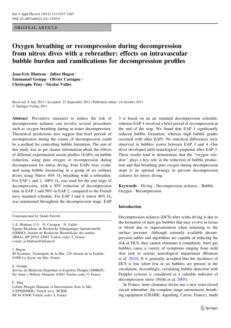

Authors: Marko Ljubkovic, Jaksa Zanchi, Toni Breskovic,
Jasna Marinovic, Mihajlo Lojpur, and Zeljko Dujic
Scuba diving leads to tissue gas supersaturation during
ascent and venous gas emboli (VGE) formation. VGE
crossover to systemic arteries (arterialization), mainly
through the patent foramen ovale, has been implicated in
various diving-related pathologies. Since recent research
has shown that arterializations frequently occur without
cardiac septal defects, this study aimed to investigate the
mechanisms responsible for these events.
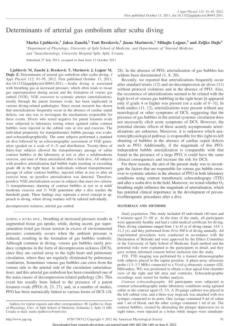

Authors: O. Hyldegaard, D. Kerem, Y. Melamed
Deep tissue isobaric counterdiffusion that may cause
unwanted bubble formation or transient bubble growth
has been referred to in theoretical models and
demonstrated by intravascular gas formation in animals,
when changing inert breathing gas from nitrogen to
helium after hyperbaric air breathing. The authors visually
followed the in vivo resolution of extravascular air bubbles
injected at 101 kPa into nitrogen supersaturated rat
tissues: adipose,spinal white matter, skeletal muscle or tail
tendon.
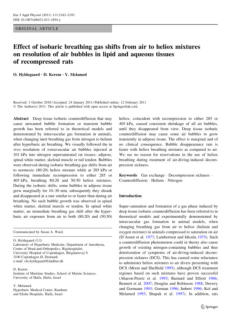


Authors:
A.C.P.K. Siriwardhana, R.G.N. Meegama, and G.M.L.P.
Aponsu
Sound waves propagate in all direction through air and
materials due to diffraction effect. Interference of sound
signals generated by several devices could create a noisy
state which is harmful for the human being at certain
instances in which noise intensity level is beyond 90 dB.
The system discussed in this research, facilitates to find
noise intensity levels at different places simultaneously and
further it identifies and point out the places where the
noisy state is harmful for human being. Corresponding
calculation by the system is mainly done based on the
direct source and reflection effects for the selected area.


Authors: J.C. Rostain, C. Lavoute, J.J. Risso, N. Vallee, M.
Weiss
Nitrogen narcosis occurs in humans at around 0.4 MPa (4
ATA). Hydrogen narcosis occurs between 2.6 and 3.0
MPa. In rats, nitrogen disturbances occur from 1 MPa and
a loss of righting reflex around 4 MPa.
Neurochemical studies in striatum of rats with nitrogen at
3 MPa with differential pulse voltammetry have
demonstrated a decrease in dopamine (DA) release by
neurons originated from the substantia nigra pars
compacta (SNc). Such a decrease is found also with
compressed argon, which is more narcotic than nitrogen
and with the anesthetic gas nitrous oxide. Inversely,
compressed helium with its very low narcotic potency
induces DA increase. Microdialysis studies in the striatum
have indicated that nitrogen also induces a decrease of
glutamate concentration. receptors activities in SNc.
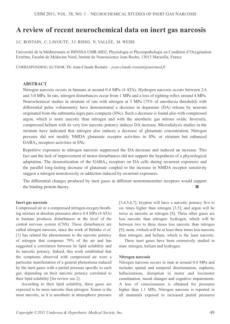

Authors: Christian R Gutvik, Tor Arne Johansen, Alf O
Brubakk
The objective of the work presented in this article is to
minimize the time spent decompressing.


Authors:
Andreas Møllerløkken, Toni Breskovic, Ivan Palada, Zoran
Valic, Zeljko Dujic and Alf O Brubakk
The aim of this study was to compare the number of
venous gas bubbles observed following a short, deep,
and a shallow long air dive performed in a hyperbaric
chamber, and following actual dives in open water.
The authors conclude that diving in water produces
significantly more bubbles than dry diving.
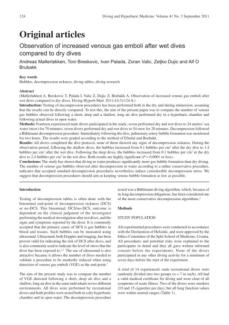

Authors:
Jean-Eric Blatteau, Emmanuel Gempp, Pascal Constantin
and Pierre Louger
This study was conducted to examine the influence of
short delays to recompression and other risk factors
associated with the development of severe neurological
decompression sickness in military divers.
Fifty-nine divers, treated for decompression sickness in less
than 6 hours, were included respectively. Diving
parameters, symptom latency, and recompression delay
were analyzed. Clinical symptoms were evaluated for
both the acute event and one month later.
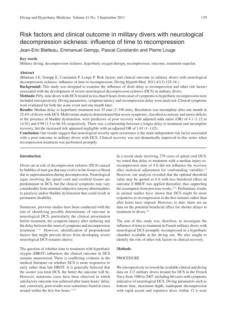

Authors: Austin Cope, Joan V Eggert and Erin O’Brien
This study describes a case series of 11 patients with
retinal artery occlusion treated with hyperbaric oxygen
therapy (HBOT) at Intermountain Dixie Regional Medical
Center between 2005 and 2009. the authors then
combined data from our case series with data from two
other case series to report a combined total of 51 patients.
Eight of 11 patients achieved improved visual acuity.
Analysis of the combined case series showed that 74% of
patients treated with HBOT had an improvement in visual
acuity, with 53% improving by two lines or more on a
modified Snellen valu
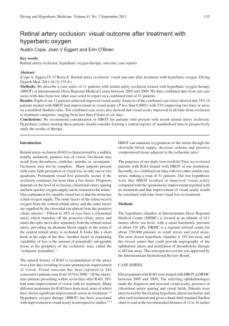

Authors: S Lesley Blogg and Mikael Gennser
Audio Doppler ultrasound and echocardiographic
techniques are useful tools for investigating the formation
of inert gas bubbles after hyperbaric exposure and can
help to assess the risk of decompression sickness
occurrence.
This review summarises comprehensive Doppler data
collected over 15 years across many dive profiles and then
assesses the effectiveness of measurements made
between 30 and 60 minutes (min) post-dive (commonly
measured time points made in recent studies) in
characterising the evolution and peak of venous gas
emboli (VGE).
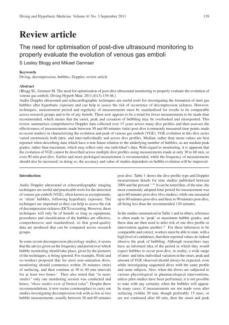

Authors: Si Jack Chong, Meng Kwan Tan, Weihao Liang,
Soo Joang Kim and Chai Rick Soh
Both negative pressure wound therapy (NPWT) and
hyperbaric oxygen therapy (HBOT) are useful modalities
in the treatment of problematic wounds. However, none
of the commercially available portable negative-pressure
devices has been certified safe for use in a recompression
chamber. Thus, the NPWT device is removed while the
patient undergoes HBOT. The purpose of this study is to
demonstrate that wound negative pressure can be
effectively and safely maintained during HBOT.
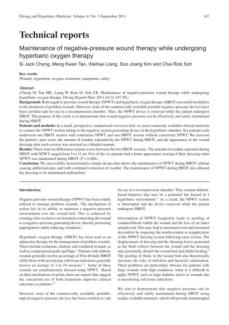

Authors: Christian Mehl, Frank Heblich, Rudolf Lenz, Klaus
Ludwig and Matthias Kern
The purpose of this in-vitro study was to determine
whether there is a correlation between a hyperbaric
environment increased oxygen partial pressure, and the
corrosion of dental alloys used for dental restorations in
divers.
Samples of three commercially available dental alloys were
tested in the DIN EN ISO 1562 static immersion test, and
the amount of dissolved ions was measured using atomic
absorption spectrometry.
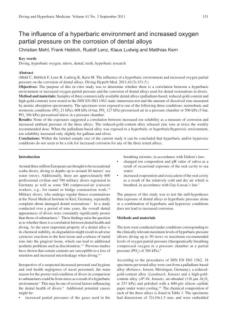

Authors: Denis A. Tolstun, Khachik K. Muradian, Vladislav
V. Bezrukov
Interest in hypercapnia and its practical applications has
significantly grown. An analysis of literary data shows a
wide range of systemic and local applications. Due to its
powerful effect on blood circulation, vascular elasticity,
activation of angiogenesis, and inhibition of pro-
inflammatory factors, hypercapnia is already used in
dermatology, phlebology, and therapy. Wide
opportunities open up for use in neurology, given the
powerful neuroprotective effect of carbon dioxide, which
not only increases tolerance to ischemia, preventing the
development of diseases, but can also become a tool for
the treatment of stroke and heart attack.
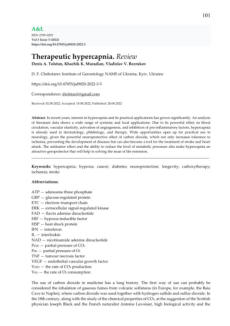

Click on the octopus
to return to the top
of the page



Authors: S.K. Hooker et al.
The study reviews the evidence of gas bubbles in the
tissues of marine mammals and discusses theories of gas
loading and bubble formation. It suggests that diving
mammals adjust their physiological responses to various
stressors and proposes a shift in focus from minimizing to
managing N2 load. This opens up multiple research
avenues, from studying the effects of gas bubbles at
various biological levels to examining their relationship
with diving behavior. Technological advancements in
imaging and remote instrumentation are expected to
further enhance this field of study. .
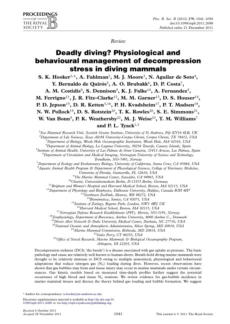



Authors: I. A. Brownlee, A. C.Fairclough, A. C. Hall, and J.
R. Paxman
This study intends to provide a comprehensive review of
the current evidence regarding the consumption of
seaweed and seaweed isolates, their potential health
benefits, and their applications in food products. Gaps in
current knowledge and suggested future research
strategies to maximize the potential uses of seaweed in
food products are also highlighted.
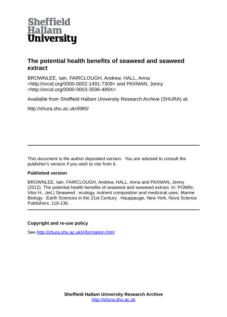

Authors: R. Arieli, A. Marmur
This document presents and supports a scientific
hypothesis regarding the origin of bubbles that cause
decompression sickness. The authors propose that
nanobubbles forming on hydrophobic surfaces
submerged in water may serve as gas micronuclei
responsible for bubble evolution during decompression.
To support their hypothesis, they describe an experiment
involving hydrophilic and hydrophobic silicon wafers,
showing that bubbles evolved only on hydrophobic
surfaces after decompression.
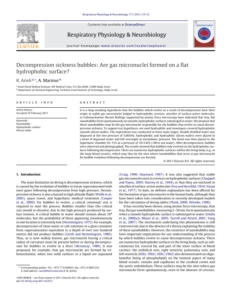

Authors: Pierre-Emmanuel Rautou, Anne-Clemence Vion,
Nicolas Amabile, Gilles Chironi, Alain Simon, Alain
Tedgui, Chantal M. Boulanger
This document explains the role and impact of
membrane-shed submicron microparticles (MPs) in the
context of atherothrombotic diseases and atherosclerosis.
That includes the origin and release of MPs during cell
activation or apoptosis, the potential of MPs as biomarkers
for vascular injury and predictors of cardiovascular events,
the accumulation and effects of MPs in atherosclerotic
lesions, and the mechanisms by which MPs contribute to
the development, progression, and complications of
atherosclerosis.
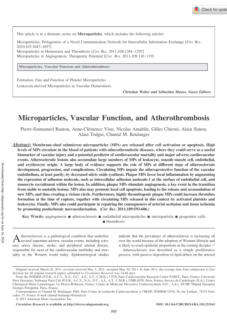

Authors: Jian-Guo Wang, Julie C. Williams, Beckley K.
Davis, Ken Jacobson, Claire M. Doerschuk, Jenny
P.-Y. Ting, & Nigel Mackman
This document presents scientific research findings on
how monocytic microparticles (MPs) activate endothelial
cells, particularly in the context of inflammation and
disease. The study investigates the mechanisms by which
MPs from lipopolysaccharide (LPS)-treated monocytic cells
induce endothelial cell activation, highlighting the role of
IL-1 Beta and inflammasome components in this process.
The research aims to elucidate the pathways involved and
the potential implications for inflammatory diseases.


Authors:
Anni Vanhatalo, Jonathan Fulford , Stephen J. Bailey,
James R. Blackwell, Paul G. Winyard, & Andrew M. Jones
This text conveys the findings of a study that demonstrates
the benefits of dietary nitrate supplementation in
improving muscle efficiency and exercise tolerance under
conditions of reduced oxygen availability (hypoxia). It aims
to inform readers that nitrate can be converted in the
body to nitrite and nitric oxide, which help reduce muscle
fatigue and enhance oxygen delivery to muscles. It
suggests potential applications of dietary nitrate for
improving exercise performance at high altitudes and in
medical conditions that impair oxygen delivery to muscles.
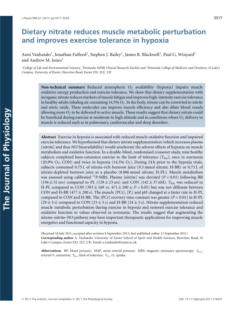

Authors:
Ming Yang, Tatyana N. Milovanova, Marina Bogush,
Günalp Uzun, Veena M. Bhopale, and Stephen R. Thom
This study investigates how decompression stress leads to
an increase in the number and size of annexin V-coated
microparticles derived from various cell types. The
research explores the hypothesis that these changes are
due to inert gas bubbles and can be mitigated by
hydrostatic pressure. The study further examines the
proinflammatory potential of these particles and their role
in vascular damage, demonstrating that particles from
decompressed mice cause significant inflammatory and
vascular changes when injected into mice.
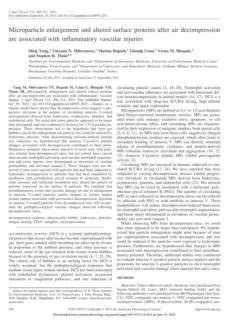

Author: Valerie Flook
This study focuses on calibrating a mathematical model
that predicts bubble formation in tissues and blood during
decompression from hyperbaric exposure. It explains the
methodology used, including combining inert gas and
bubble dynamics models and comparing model
predictions with Doppler scores. It also highlights the
application of the model in evaluating decompression
stress and assisting regulators and professionals in setting
acceptable decompression risk limits and designing
effective decompression procedures.
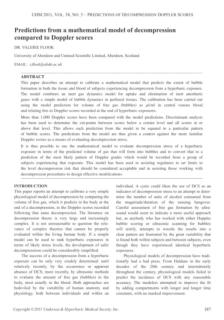



5 - The influence of a hyperbaric environment and increased
oxygen partial pressure on the corrosion of dental alloys.

Authors: Christian Mehl, Frank Heblich, Rudolf Lenz,
Klaus Ludwig and Matthias Kern
Theourpose of this in-vitro study was to see if a hyperbaric
environment or higher oxygen pressure affects the
corrosion of dental alloys used in divers. Three types of
dental alloys were tested under different pressure
conditions. Results showed no link between higher
pressure and increased corrosion for the three alloys.
However, one alloy released more zinc ions than
recommended. Overall, hyperbaric and hyperoxic
conditions did not increase corrosion risk for any alloy
tested.
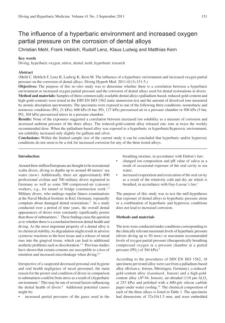



6 - Maintenance of negative-pressure wound therapy while
undergoing hyperbaric oxygen therapy.
Authors: Si Jack Chong, Meng Kwan Tan, Weihao Liang,
Soo Joang Kim and Chai Rick Soh
This study aims to show that NPWT can be safely used
during HBOT. Six patients participated, assessing pain,
exudate, and dressing appearance. Results showed no
pain differences, but five patients had better dressing
appearance with NPWT during HBOT




7 - The need for optimisation of post-dive ultrasound monitoring to
properly evaluate the evolution of venous gas emboli.
Author: S Lesley Blogg, and Mikael Gennser
This review presents 15 years of Doppler data and
evaluates measurements taken 30 to 60 minutes post-
dive, showing significant variation in venous gas emboli
(VGE). It suggests more frequent and earlier
measurements to enhance study accuracy.
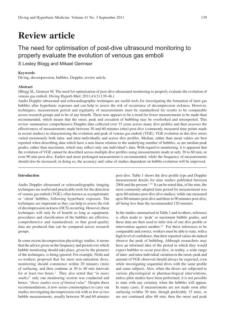




8 - Retinal artery occlusion: visual outcome after treatment with
hyperbaric oxygen.
Authors: Austin Cope, Joan V Eggert and Erin O’Brien
This paper describes a case series of 11 patients with
retinal artery occlusion treated with hyperbaric oxygen
therapy (HBOT) from 2005 to 2009. Combining data with
two other series, the authors analyzed a total of 51
patients.
Eight of our 11 patients showed improved visual acuity. In
the combined analysis, 74% improved, with 53% gaining
two lines or more. Improvement occurred in all treatment
time categories.
As a conclusion, the study recommends considering
HBOT for recent retinal artery occlusion cases and
suggests forming a central registry for standardized data
collection to study therapy results.
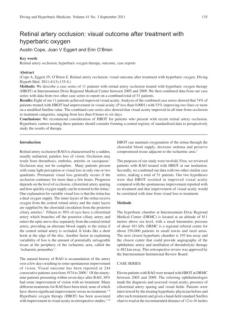




9 - Risk factors and clinical outcome in military divers with
neurological decompression sickness: influence of time to
recompression.
Authors: Jean-Eric Blatteau, Emmanuel Gempp, Pascal
Constantin and Pierre Louge
This study examined the influence of short delays to
recompression and risk factors leading to severe
neurological decompression sickness (DCS) in military
divers. Fifty-nine divers treated within 6 hours were
analyzed for diving parameters and symptom recovery.
Results showed a median treatment delay of 35 minutes,
with 25. 4% showing incomplete recovery after one
month. Severe symptoms predicted poor recovery, while
the delay to treatment had a minimal effect. The main
factor for a poor outcome was neurological severity at
onset.





15 - Preventing Decompression Sickness Over Three Decades of
Extravehicular Activity.
Author: Johnny Conkin
The shuttle Space Transportation System has ended its 30-
year operation. Advances were made in understanding
decompression sickness through research and
spacewalks. Key lessons include better management of
depressurization, methods for faster denitrogenation, and
development of effective pre-breathe protocols for
spacesuits. Future exploration can benefit from these
findings.
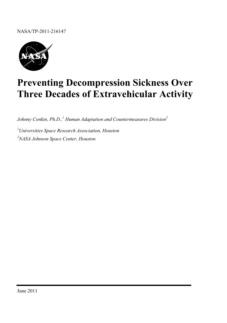




21 - Dive Computer Program Management in Scientific Diving.
Author: Michael A. Lang
The Smithsonian Institution Scientific Diving Program is a
major civilian diving program in the U. S. since 1990. In
2005, a virtual dive office called DECOSTOP was created
to manage diving activities. Launched in 2007,
DECOSTOP allows for submitting applications,
maintaining records, entering logs, and authorizing
projects. Since 2010, diving has required Smithsonian-
issued computers to upload profiles to DECOSTOP,
improving efficiency and monitoring of the program.





22 - Dive Computer Use in Recreational Diving: Insights from the
DAN-DSL Database
Author: Costantino Balestra
Data from the DAN Europe Diving Safety Laboratory
(DSL) shows that about 95% of recreational divers uss dive
computers. Most computers use the Bühlmann ZHL-16 or
Wienke RGBM algorithms. Most DCS cases occurred
within safe limits of these algorithms. Other physiological
factors may contribute to DCS. A more aggressive
“biological” approach is suggested to identify and control
significant factors affecting DCS, beyond just gas levels.
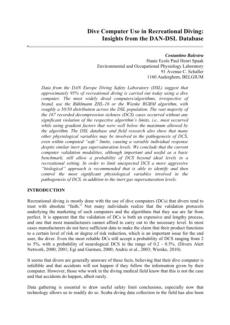




23 - The Use of Venous Gas Emboli to Validate Dive Computers.
Authors: Lesley Blogg, Andreas Mollerlokken
Venous gas emboli (VGE) usually accompany DCS and
are a reliable indicator of decompression stress. VGE
provides an objective measure and allows for a smaller
sample size without ethical concerns. Statistical methods
can estimate DCS risk. Dive computers (DC) can be tested
using common dive profiles to find the best model while
measuring the lowest VGE production, which can then
be validated further.
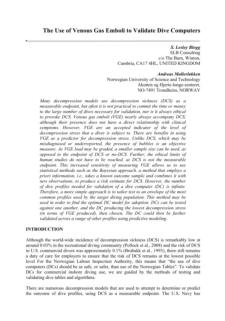




24 - Validation of Dive Computer Algorithms
Author: Sergio A. Angelini
Results of a comprehensive effort to analyze commercially
available dive computers and PC-based dive planners are
reviewed. For this study 234 chamber test dives were
carried out with profiles ranging from square to
triangular, multilevel forward and multilevel reverse, to a
maximum depth of 54 m. Air was the breathing medium
for all dives. A first phase considered only no
decompression dives, a second phase considered
decompression dives at two levels of PRT (pressure root
time) and a third phase considered repetitive dives with
various surface intervals.
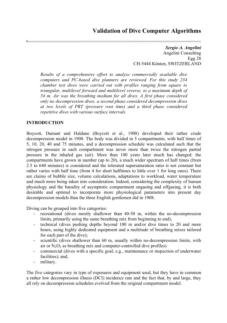




25 - US Navy dive computer validation
Author: David J. Doolette, Keith A. Gault, Wayne A.
Gerth, F. Greg Murphy
The U. S. Navy Dive Computer (NDC) is a diver-carried
device using a straightforward decompression algorithm
to give real-time schedules. Unlike many, the NDC uses a
proven algorithm from extensive diving tests, making its
validation easier. However, challenges arise for computers
lacking documented algorithms.
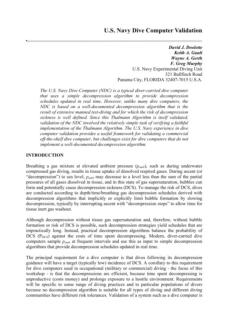




26 - Dive Computers: The Need for Validation and Standards
Authors: Arne Sieber, Milena Stoianova, Ewald Jobstl,
Alaine Azzopardi, Martin DJ Sayer, Matthias F.
Wagner
TDive computer validation is a hot topic with no standard
testing procedures. Manufacturers often claim their
products are personal protective equipment (PPE), but
they are not listed under the PPE Directive 89/686/EEC.
EN13319 is a common standard for CE certification,
focusing on depth sensor accuracy, not decompression
calculations. A market survey shows how manufacturers
certify their CE products. Testing is crucial for liability, as
these devices aid in decompression planning. A new
standard is proposed to improve validation and safety for
dive computers.




27 - Dive computer considerations
Author: Karl E Huggin
Dive computers are essential in different types of diving
but are often not allowed for determining decompression
status in commercial diving. Their ability to update
decompression status can enhance dive time efficiency.
However, limited human studies on their algorithms mean
a need for evaluating decompression risk for commercial
use. This paper discusses testing dive computers against
known human diving results to assess risk levels. Merging
this technique with risk models could improve algorithm
evaluations, increasing efficiency in commercial diving
operations.
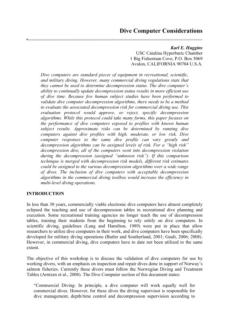




28 - Dive computer validation procedures
Author: RW Bill Hamilton
The term "validation" is key to the goals of the 2011 dive
computer workshop. Previous studies have assessed dive
computers and tables. Understanding a dive computer's
function is essential for the validation process.





29 - Advances in diagnosis and treatment of cerebral arterial gas
embolism
Author: Robert Weenink
The underwater environment presents unique challenges
due to hyperbaric exposure, like oxygen toxicity and risk of
decompression sickness. Barotrauma may occur from
pressure differences, leading to cerebral arterial gas
embolism (CAGE). The Royal Netherlands Navy faces
these risks, prompting research into CAGE, its causes,
diagnosis, and treatment. The first chapter provides an
overview, followed by investigations on diagnosis and
treatment in later chapters





30 - Surface nanobubbles as a function of gas type.
Author: Michiel A. J. van Limbeek, and James R. T.
Seddon
This document is a study on the formation of surface
nanobubbles on perfluorodecyltrichlorosilane-coated
silicon based on the type of gas in water. It shows that
nanobubble formation varies significantly with gas type,
with an optimal temperature of about 35 - 40°C for
maximum nucleation, showing slight dependence on gas
type. Its authors also observe that contact angle changes
with the nanobubble's curvature for all gases studied. The
analysis of this data reveals a line tension related to the gas
type, indicating that nanobubbles sit above adsorbed gas
molecules.





31 - British Sub-Aqua Club (BSAC) diving incidents report 2010
Author: Michiel A. J. van Limbeek, and James R. T.
Seddon
The BSAC has compiled an annual report on diving
incidents for over 20 years, mainly from the UK. In 2010,
there were 364 UK reports, below the 10-year average.
While some reports may be incomplete, fatality numbers
are considered accurate. There is a decline in ascent
incidents since 2006, showing the impact of training. The
Coastguard handled 65% of incidents, with the RNLI
assisting in rescues and searching for missing divers.
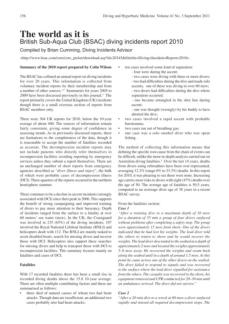




32 - Ward’s Hierarchical Clustering Method: Clustering Criterion and
Agglomerative Algorithm.
Authors: Fionn Murtagh, and Pierre Legendre
The Ward error sum of squares hierarchical clustering
method was first described by Ward in 1963 and has
been widely used. It has various interpretations and
different implementations in software systems. Our survey
work and case studies will help those developing software
for data analysis using Ward’s method.
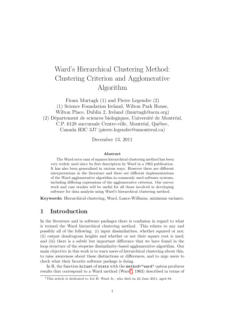



35 - The genetic component of the forced diving bradycardia
response in mammals

Authors: Andreas Fahlman, Brian L. Bostrom, Kiran H.
Dillon, and David R. Jones
This study compared forced diving bradycardia between
two genetically similar rat strains (Fischer and Buffalo)
and outbred rats (Wistar). The inbred rats showed a
significant difference in dive bradycardia, while the
outbred rats showed an intermediate response. The
decreased variability in fH in the inbred rats suggests
reduced genetic variability minimizes variability of diving
bradycardia between individuals. The results suggest
that a portion of mammalian diving bradycardia may be
a heritable trait.












